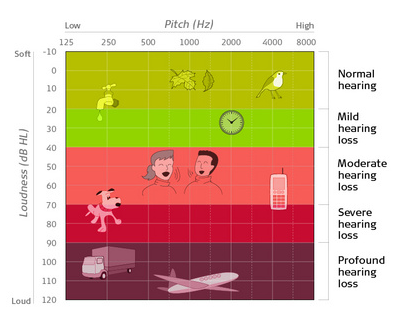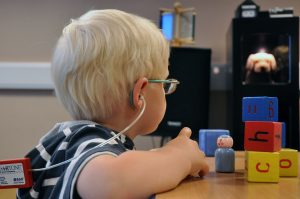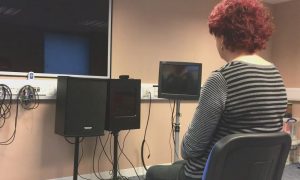Cochlear implants are recommended for people with bilateral (both ears) severe to profound sensorineural hearing loss, who do not get sufficient benefit from hearing aids for speech perception or awareness of environmental sounds.
Age is not a limitation, at the time of writing this the youngest patient implanted at USAIS was 6 months old, and the oldest was 94 years.
In the UK, criteria for cochlear implantation (when funded by the NHS) is set by the NICE technology appraisal [TA566] – which cochlear implant centres have to adhere to.
Click on the clips below to hear about patient experiences of the assessment process
ADULTS
CHILDREN
Click on the tabs below to find out more about the test criteria and about the assessment process.

The chart above is called an audiogram (image courtesy of MED-EL). When you have a hearing test you listen to pure tones of different frequencies through headphones. The level at which you can just hear the sounds is marked on the chart. The further down the chart you are the louder the sound has needed to be for you to hear it. Low pitch sounds are presented to the left of the chart and then as you move across the chart to the right the pitch gets higher. To be in criteria for a cochlear implant hearing levels (without hearing aids) need to be worse than 80dBHL at 2 frequencies (500Hz, 1,000Hz, 2,000, 3,000Hz and 4,000Hz) on the chart.
This test is scored by asking the patient to repeat a list of spoken words. The final score being the number of correctly identified phonemes from each word. Adult patients need to score less than 50% at a sound intensity of 70 dB SPL using their hearing aids in their best aided condition in order to be in criteria for a cochlear implant.
The University of Southampton Auditory Implant Service (USAIS) will need to assess each individual patient to ensure they meet the criteria. We carry out hearing tests and age appropriate speech tests  with and without the patient’s hearing aids. For children who are too young for speech tests, the unaided hearing test is used as the criteria and we monitor their speech and language ability and responsiveness to sound. It can take several appointments at the clinic and staff will make visits to the child’s home and talk to local professionals in order to get a full picture of a child’s hearing.
with and without the patient’s hearing aids. For children who are too young for speech tests, the unaided hearing test is used as the criteria and we monitor their speech and language ability and responsiveness to sound. It can take several appointments at the clinic and staff will make visits to the child’s home and talk to local professionals in order to get a full picture of a child’s hearing.
For children only:
USAIS will also carry out an Auditory Brainstem Response (ABR) test which gives an estimate of hearing thresholds without requiring the patient to respond to sound. The recording of the ABR is usually done under local anaesthetic whilst the child is having their CT and MRI scans.
One or two implants?
Simultaneous bilateral cochlear implantation (two ears at the same time) is offered to all children. Adults who are blind or who have other disabilities that increase their reliance on auditory information can also apply for 2. Unilateral cochlear implantation (one ear) is offered to all other adults. Children not considered clinically/medically suitable for bilateral implants can also have just one.
Sequential bilateral implants (two ears implanted at different points in time) is offered to people who had a unilateral implant before the NICE guidance was published in January 2009, and who fall into one of the above categories. Sequential bilateral cochlear implantation is not recommended as an option for people with severe to profound deafness. Where possible, two implants at the same surgery time is recommended.
There are special cases where the above do not apply:
Auditory Neuropathy Spectrum Disorder (ANSD) –Some patients with ANSD will not fit within the NICE criteria but might still be eligible for a cochlear implant if the hearing aids are not facilitating speech and language development. For these cases hearing levels are not used for guidance, but rather how well the patient is functioning in terms of hearing and their development of speech
Key concepts
- What is a cochlear implant?
- How does it work?
- Who should have a cochlear implant?
- What does a cochlear implant sound like?
- Who manufactures cochlear implants?


